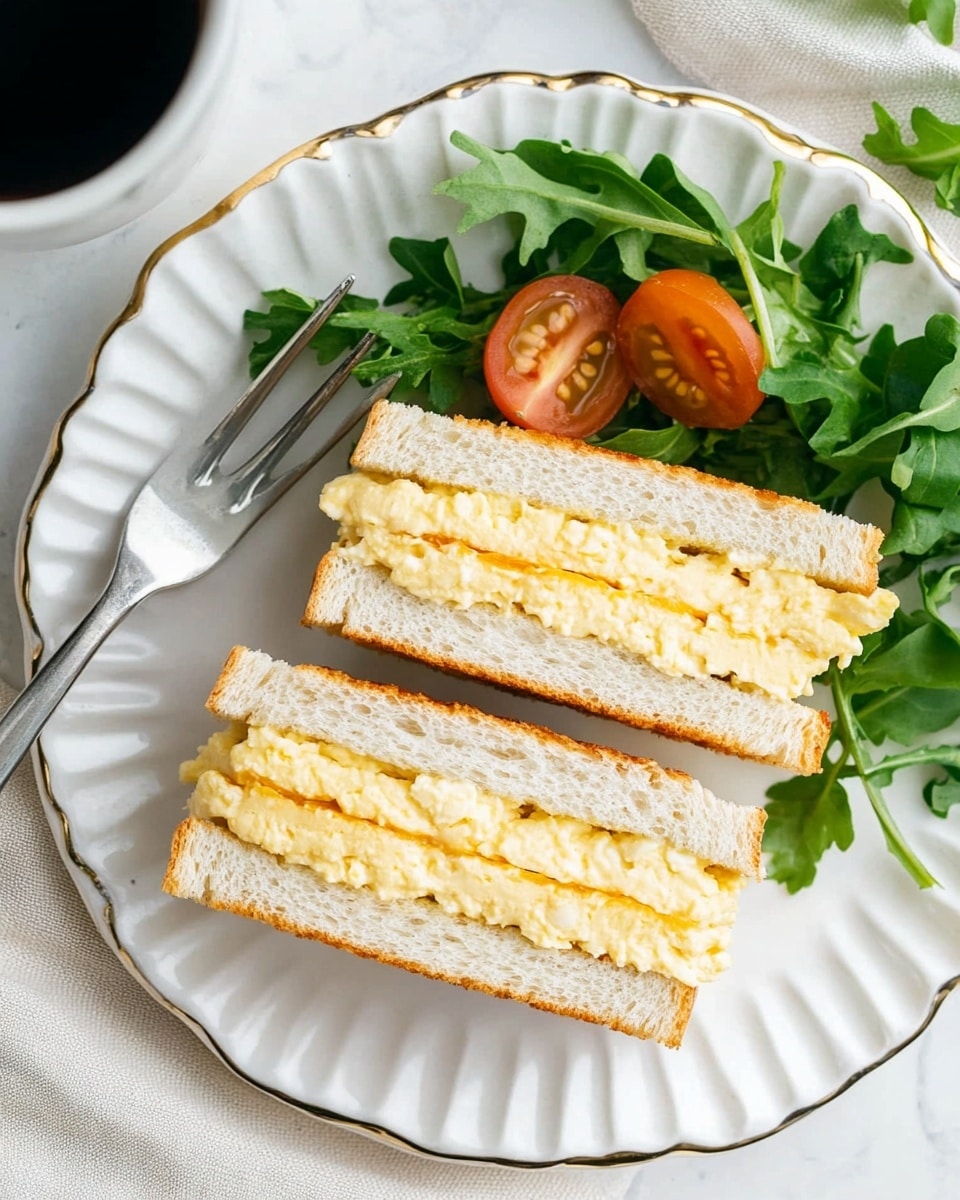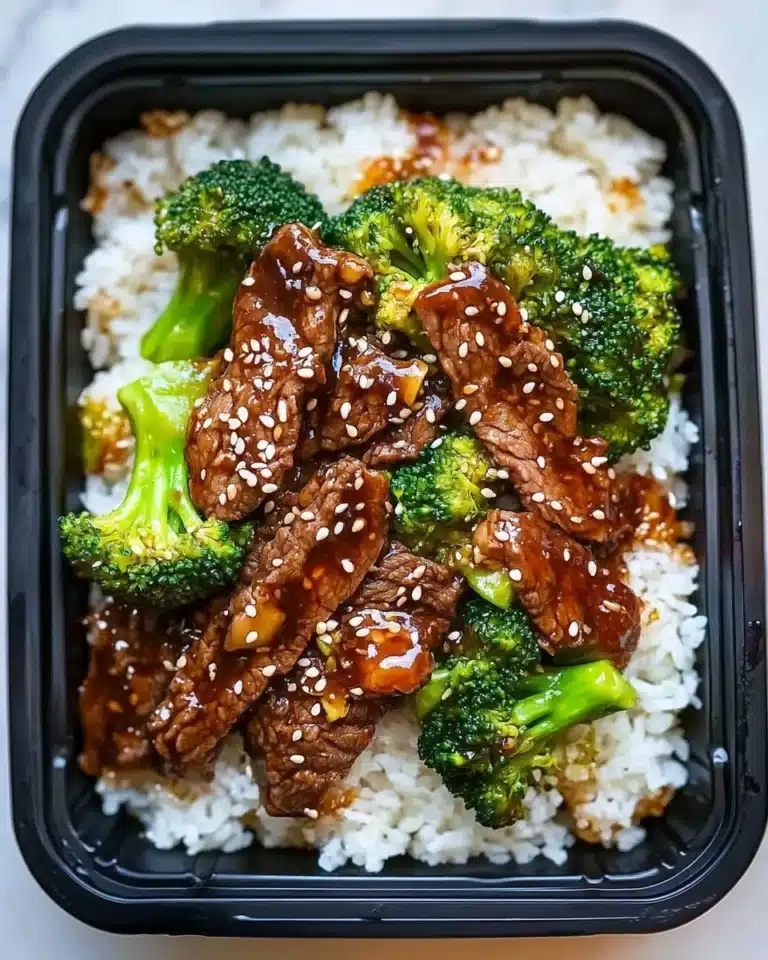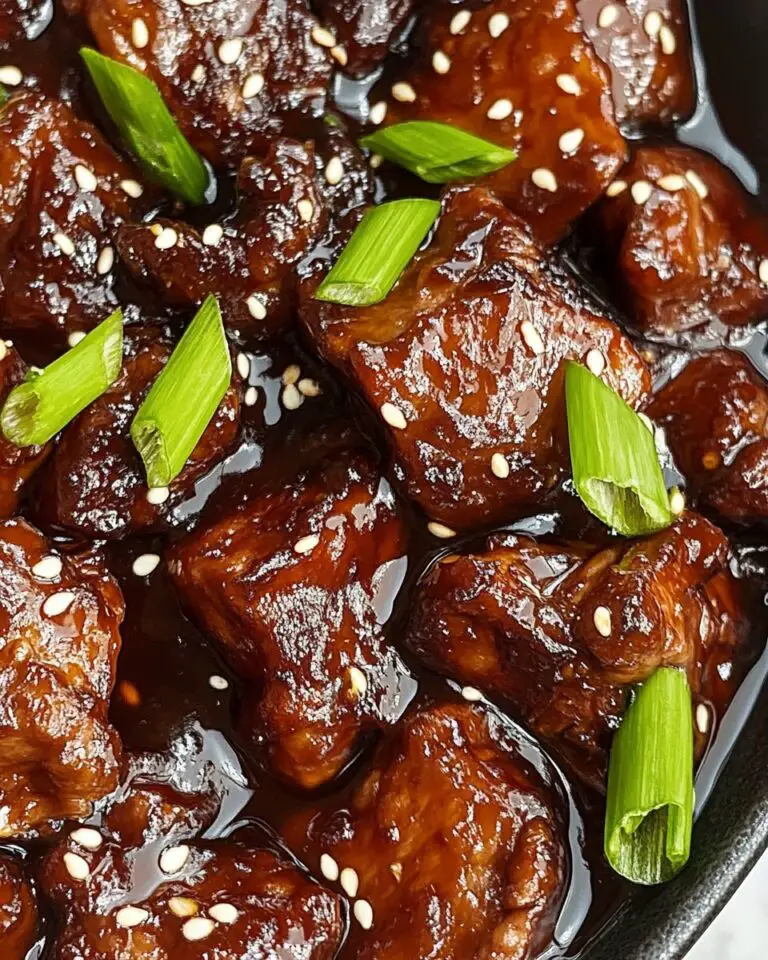I absolutely love making this Japanese Egg Sandwich (Tamago Sando) recipe whenever I want a simple yet comforting treat that feels special. This sandwich is more than just eggs on bread – it s creamy, fluffy, lightly seasoned, and wrapped in pillowy soft shokupan (Japanese milk bread), which makes every bite feel like a small celebration. If you ve never tried this before, you re in for a delightful surprise that s perfect for breakfast, lunch, or even a picnic snack.
When I first tried the Japanese Egg Sandwich (Tamago Sando) recipe, I was blown away by how easy it was to make and how well the gentle flavors come together. You’ll find that it s not only quick to whip up but incredibly satisfying, with a creamy egg filling that s subtly sweet and savory. Plus, it’s a great way to impress guests or treat yourself without a lot of fuss, and I think you ll find it a staple in your kitchen once you ve tasted it.
Why You’ll Love This Recipe
- Simplicity Meets Elegance: This sandwich is incredibly easy to make but tastes like a gourmet treat.
- Perfect Texture Balance: Soft shokupan bread pairs beautifully with creamy, tender egg filling for a satisfying mouthfeel every time.
- Customizable Comfort Food: You can easily adjust seasoning and add-ins to make it your own without losing its signature charm.
- Great for Any Occasion: Whether it’s a quick weekday snack or a delightful addition to your brunch spread, this sandwich always shines.
Ingredients You’ll Need
Each ingredient in this Japanese Egg Sandwich (Tamago Sando) recipe plays a crucial role in creating that perfect balance of flavor and texture. Using fresh eggs, quality mayonnaise, and authentic shokupan bread will elevate your sandwich to the next level.
- Large eggs: Fresh eggs make the filling creamy yet firm once cooked perfectly.
- Sugar: Just a pinch enhances the natural sweetness in the eggs without overpowering the sandwich.
- Kosher salt (Diamond Crystal preferred): Its clean flavor really brings the egg salad to life.
- Freshly ground black pepper: Adds subtle heat and complexity.
- Milk: A small amount keeps the egg filling extra soft and moist.
- Japanese Kewpie mayonnaise: This mayo is tangier and richer than the standard kind-a total game-changer here.
- Shokupan (Japanese milk bread): The signature fluffy, slightly sweet, and buttery bread that makes the sandwich truly authentic. If you can t find it, look for soft milk bread or brioche as substitutes.
- Salted butter: Spreading this on the bread adds richness and a slight salty contrast to the soft egg filling.
Variations
I like to keep the base of this Japanese Egg Sandwich (Tamago Sando) recipe simple, but sometimes I enjoy mixing things up by adding a little twist. The beauty of this sandwich is its versatility, so don t hesitate to experiment with flavors or even breads to find what suits your taste perfectly.
- Avocado Mash: Adding sliced or mashed avocado gives a creamy, buttery layer that pairs amazingly with the egg filling – my family goes crazy for this variation.
- Wasabi Mayo: Mix a tiny bit of wasabi into the Kewpie mayo for a subtle kick that gives a refreshing twist without overpowering the sandwich.
- Herb Boost: Fresh herbs like chives, parsley, or shiso leaves add brightness and color to the egg salad.
- Whole Wheat Shokupan: For a healthier option, try whole wheat or mixed grain shokupan bread – it adds texture and nuttiness that s delicious too.
How to Make Japanese Egg Sandwich (Tamago Sando) Recipe
Step 1: Perfectly Boil Your Eggs for Creamy Texture
Start by placing 3 large eggs in a medium saucepan filled with enough water to cover them by about an inch. Bring the water to a boil over medium heat, then let the eggs cook for exactly 12 minutes. I always set a timer because if you overcook the eggs, the yolks get chalky and dry, which changes the creamy texture we want. Once done, transfer the eggs immediately into iced water – this cools them quickly and stops the cooking process, preventing that greenish ring around the yolks and ensuring a smooth, tender texture.
Step 2: Mash and Season the Egg Filling
After your eggs are fully cooled, peel them carefully. I ve learned peeling under running cold water helps remove shells without damaging the whites. Place the peeled eggs in a bowl and mash them with a fork until the whites are broken into small, even pieces – I like it to still feel a bit chunky for texture rather than a uniform paste. Then, add ¼ teaspoon sugar, ¼ teaspoon kosher salt, ⅛ teaspoon freshly ground black pepper, and 2 teaspoons of milk. Mix all these gently to combine.
Step 3: Stir in Kewpie Mayonnaise for That Iconic Creaminess
Add 2 tablespoons of Japanese Kewpie mayonnaise and mix thoroughly until everything is smooth and creamy. I always taste at this point and adjust salt and pepper as needed – it s the little seasoning tweaks here that make the flavor sing. The Kewpie mayo gives a slightly tangy, rich flavor that s far superior to regular mayo in this recipe, so I recommend it if you can find it at your local Asian market or online.
Step 4: Butter and Assemble Your Sandwich
Lay out 4 slices of shokupan. Spread salted butter generously on each slice; this step adds a lovely richness and keeps the bread moist when layered with the egg salad. Then, spread the egg filling thickly on two of the slices and top each with the other buttered slice, butter side down. To get that iconic compact sandwich, place the sandwiches between two plates and gently press them for about 5 minutes – this slightly compresses the sandwich, melding all the flavors together beautifully.
Step 5: Trim Crusts and Serve
Once your sandwiches are pressed, carefully cut off the crusts. I don t throw these away – I save them to make crunchy Shokupan Crust Rusks later, which are fantastic snacks. Cut each sandwich into halves or quarters, whichever you prefer, and your Japanese Egg Sandwich (Tamago Sando) is ready to enjoy.
Pro Tips for Making Japanese Egg Sandwich (Tamago Sando) Recipe
- Egg Cooking Precision: Use a timer every time you boil eggs to avoid over or under cooking; 12 minutes is your sweet spot for this recipe.
- Mashing for Texture: Don t mash the eggs completely smooth; leaving small chunks gives your filling a more authentic, homemade feel.
- Choose the Right Bread: Authentic shokupan bread is buttery and soft – if unavailable, brioche is an excellent substitute to keep that pillowy softness.
- Compression Magic: Pressing sandwiches between plates for several minutes makes the flavors meld and improves the sandwich s texture dramatically.
How to Serve Japanese Egg Sandwich (Tamago Sando) Recipe

Garnishes
When I serve this sandwich, I like to keep it simple with minimal garnishes to highlight the creamy egg filling, but a touch of fresh parsley or a sprinkle of finely chopped scallions adds a fresh, vibrant punch. Occasionally, I add a few thin slices of cucumber or a light drizzle of soy sauce mayo on the side for an extra flavor layer.
Side Dishes
This sandwich pairs beautifully with light sides like a crisp green salad with a citrus vinaigrette or pickled vegetables to cut through the richness. I ve also enjoyed it alongside a simple bowl of miso soup or crispy sweet potato fries for a cozy meal.
Creative Ways to Present
For a special occasion or party, I love cutting the sandwiches into small bite-size squares and arranging them on a platter with colorful garnishes like edible flowers and microgreens. Another idea is to layer the filling inside mini slider buns for a fun appetizer twist that guests always appreciate.
Make Ahead and Storage
Storing Leftovers
If you happen to have leftovers, store the assembled sandwiches in an airtight container in the fridge for up to 2 days. I find they keep their texture well if you avoid stacking too many on top of each other and press them lightly again before serving to bring back that freshly made feel.
Freezing
I don t typically recommend freezing the entire sandwich because the bread can get soggy after thawing. However, you can freeze the egg filling separately in an airtight container for up to a month and assemble sandwiches fresh when you want them later.
Reheating
To enjoy leftovers, I warm the sandwiches at room temperature or briefly toast the bread in a pan to soften any firmness, but I avoid microwaving as it can dry out the eggs. A quick pressing between two warm plates or a light buttered toast makes each bite just as good as when freshly made.
FAQs
-
What makes the egg filling in a Japanese Egg Sandwich different from regular egg salad?
The egg filling in a Japanese Egg Sandwich (Tamago Sando) recipe is known for its smooth, creamy texture and mild, slightly sweet flavor. Unlike traditional egg salad, it uses Japanese Kewpie mayonnaise which is richer and tangier, a pinch of sugar, and milk to keep the filling soft and delicate.
-
Can I use regular bread instead of shokupan for this sandwich?
Yes, you can substitute shokupan with soft white bread or brioche if you can t find it. The key is choosing bread that s soft and slightly sweet to mimic the original texture and flavor as closely as possible.
-
How do I prevent the sandwiches from becoming soggy?
Spreading salted butter on the bread before adding the egg filling creates a moisture barrier, which helps prevent sogginess. Also, assembling the sandwich shortly before eating and storing leftovers properly in airtight containers are important tips to keep them fresh.
Final Thoughts
I hope you give this Japanese Egg Sandwich (Tamago Sando) recipe a try soon – it s one of those simple pleasures that s surprisingly easy to master but feels indulgent every time you make it. Whether you re packing lunch for yourself or want to impress friends with a comforting Japanese classic, this sandwich hits all the right notes. I love how forgiving and adaptable it is, plus how it reminds me of cozy mornings and happy moments in the kitchen. So grab those eggs and that soft shokupan bread, and enjoy making this delightful sandwich – I think you re going to love every bite.
Print
Japanese Egg Sandwich (Tamago Sando) Recipe
- Prep Time: 10 minutes
- Cook Time: 15 minutes
- Total Time: 30 minutes
- Yield: 2 servings
- Category: Sandwich
- Method: Stovetop
- Cuisine: Japanese
Description
This Japanese Egg Sandwich, or Tamago Sando, is a delightful and creamy egg salad sandwich made with soft-boiled eggs, Japanese Kewpie mayonnaise, and fluffy shokupan milk bread. It’s a classic comfort food in Japan known for its simple ingredients and rich, buttery flavor, perfect for a quick lunch or snack.
Ingredients
Egg Salad
- 3 large eggs (50 g each without shell)
- 1/4 tsp sugar
- 1/4 tsp Diamond Crystal kosher salt
- 1/8 tsp freshly ground black pepper
- 2 tsp milk
- 2 Tbsp Japanese Kewpie mayonnaise
Sandwich
- 4 slices shokupan (Japanese milk bread) or homemade shokupan cut into slices of similar thickness
- Salted butter
Instructions
- Gather Ingredients: Assemble all ingredients needed for the sandwich to ensure a smooth cooking and assembling process.
- Boil the Eggs: Place the 3 large eggs in a medium saucepan and cover with water by about 1 inch (2.5 cm). Bring to a boil over medium heat, then cook the eggs for 12 minutes once boiling to achieve a firm yolk.
- Cool and Peel Eggs: Transfer the boiled eggs immediately into iced water to halt the cooking process. Let them cool completely before peeling off the shells carefully.
- Mash Eggs: Place peeled eggs in a bowl and mash them using a fork, breaking the whites into small evenly sized pieces for a pleasant texture in the salad.
- Season Egg Mixture: Add ¼ tsp sugar and ¼ tsp kosher salt to the eggs, stirring to distribute evenly.
- Add Pepper and Milk: Mix in ⅛ tsp freshly ground black pepper and 2 tsp milk to add creaminess and a subtle spice to the egg salad.
- Incorporate Mayonnaise: Add 2 Tbsp Japanese Kewpie mayonnaise and mix thoroughly until the salad is smooth and creamy. Adjust salt and pepper to taste as needed.
- Prepare Bread: Lay out 4 slices of shokupan and spread salted butter evenly on each slice to add richness and a slight savory flavor.
- Assemble Sandwich: Spread the egg salad over one buttered slice per sandwich, then top it with another buttered slice, butter side down, to enclose the filling.
- Compress Sandwiches: Place the assembled sandwiches between two plates and apply gentle pressure for about 5 minutes to allow the flavors to meld and the bread to compress slightly.
- Trim Crusts and Serve: Cut off the crusts neatly from each sandwich, then slice the sandwiches in half. Serve immediately for the best texture and freshness.
- Store Leftovers: Place any leftover sandwiches in an airtight container and refrigerate for up to 2 days to maintain freshness.
Notes
- Use freshly boiled eggs for the best texture in your egg salad.
- If you do not have Japanese Kewpie mayonnaise, substitute with a high-quality mayonnaise for similar richness.
- Shokupan bread provides the ideal softness and sweetness, but any soft white bread can be used in a pinch.
- Do not skip compressing the sandwich; it enhances the flavor and texture balance.
- Save bread crusts to make crunchy Shokupan Crust Rusks as a tasty snack.
- Consume the sandwiches within 2 days for the best taste and food safety.
Nutrition
- Serving Size: 1 sandwich
- Calories: 340 kcal
- Sugar: 4 g
- Sodium: 583 mg
- Fat: 19 g
- Saturated Fat: 4 g
- Unsaturated Fat: 14 g
- Trans Fat: 1 g
- Carbohydrates: 26 g
- Fiber: 1 g
- Protein: 14 g
- Cholesterol: 285 mg









